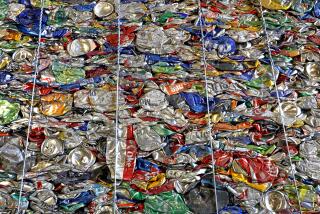Unsightly Evidence of U.S. Trade Gap Piles Up
To understand the trade deficit, residents of Sandison Street do not need the help of world-class economists.
They can just glance across the street at the mountain of faded brown cargo containers blocking the Wilmington sky.
The equation is simple. As the deficit grows, the mountain gets higher.
“It’s getting taller; it’s spreading out,” said resident Maria Lopez, eyeing the pile that stretches for two blocks.
Tens of thousands of containers sit empty today in Wilmington -- stark testimony that America buys more from other countries than it sends overseas to sell.
Millions of the 40-foot-long steel containers arrive in Los Angeles each year, jampacked with toys, MP3 players and designer handbags made in Asia.
Although some are shipped back empty, others land in storage lots, like old cardboard cartons stuffed away in a closet.
Eventually, many of the containers are reused. But some are forgotten, and they pile up -- in Wilmington and nearby cities, in communities lining the Long Beach Freeway, near rail yards in the Inland Empire.
They have transformed Wilmington into Container Land, stacked like mammoth Lego blocks five, six, even seven high, with the names of shipping firms such as Maersk, COSCO and China Shipping painted on their sides.
While experts analyze the economic problems that the containers symbolize, Wilmington residents worry about the problems with the containers themselves -- from the overgrown weeds to the earthquake dangers to the ugly views they create and the better ones they block.
Rats inspire the most anger. Residents say the rodents live in the storage yard, venturing out at night to forage. Several people described how rats creep through their wrought-iron fences, past the roses on their front lawns, and sneak right into their neat stucco homes.
That’s where homeowners -- many of whom have small children and work hard to improve their properties -- draw the line.
Where Sandison Street meets Sanford Avenue, the fence encircling the pile is topped with coiled razor wire, but neighborhood children crawl underneath and scramble up containers stacked five high. Seen from the south, the mound appears to be tilted ever so slightly to the right, a steel-block variation on the Tower of Pisa. That raises a question: In an earthquake, just how far would a steel box tumble?
As if the pile weren’t eyesore enough, scraggly weeds at its edges grow so tall that Lopez has paid from her own pocket to have them trimmed. Midnight dumpers have turned the sidewalk in front of the fence into an impromptu junkyard, leaving it littered last week with a turquoise mattress and box springs and two matching upholstered chairs.
Lopez’s next-door neighbor, Diane Richardson, has lost all patience after years of watching the mountain grow. It’s always been something, she said.
She grew up on the street in the pre-container 1960s, when what is now the storage yard was a sandy, vacant lot that she and her friends called “the dumps” because trucks dumped garbage there. Now she watches trucks dump containers instead.
“I would love to have this whole view gone,” Richardson said while gazing at the mountain from her frontyard, where she was scrubbing an inflatable pool for her great-grandchildren playing nearby. “It’s terrible. The whole thing.”
Local officials say they are trying to shrink the piles in Wilmington, a lower-income, largely Latino neighborhood of Los Angeles that has borne the brunt of the city-owned port’s rapid expansion.
Councilwoman Janice Hahn, who represents the area, calls the growth of such yards in residential neighborhoods one of the worst abuses imposed by the ports of Los Angeles and Long Beach, the nation’s first- and second-largest seaports, respectively.
“Kids are walking to school past containers stacked 40 feet high,” Hahn said recently in a statement. “Containers are literally stacked outside homes and schools. You won’t find this kind of blight in any other areas of the city.”
Hahn spearheaded a new city ordinance that prohibits new container yards in residential areas and limits their height. The city has assigned inspectors to enforce it, but the job is not easy.
Some lots are clustered together like patchwork quilts, and inspectors are still studying who operates them and whether they are in compliance.
The mountain north of Sandison Street is in an area that includes at least five lots. City officials on Friday said inspectors are investigating the site but they still have not confirmed who is responsible for it. The city attorney’s office has determined that the ordinance cannot force current yards to close, a spokesman said.
So, residents on Sandison, Dolores Street and others who hoped to see the piles disappear instead sigh as new containers arrive, delivered by trucks that clog narrow roadways and belch black diesel fumes.
No one knows how many empty containers are scattered in Wilmington and other communities around the port.
The numbers fluctuate, depending on the season, shipping costs and the cost of steel. A preliminary 2004 survey by the Alameda Corridor Transportation Authority, which operates the rail corridor serving the ports, put the number at roughly 100,000 empty containers in 2002, dropping sharply to 28,000 two years later.
The current total is somewhere in between, said John T. Doherty, the corridor agency’s chief executive officer. Wilmington residents say they did their own count last year and found 200,000.
The state Air Resources Board staff recently counted 23 storage lots in Wilmington alone.
“We were stunned, not only by the number of containers, but by the number of container yards,” said Jerry Martin, spokesman for the state agency, which is studying the yards as part of a review of Wilmington’s environmental problems.
Container colors vary.
Viewed from a distance, the reddish-brown Sandison Street mountain resembles a steep, sandstone butte. Red and blue mounds to the east near Long Beach look like stacked children’s blocks.
Trade tallies for the two ports illustrate why the mounds form. Of the more than 14 million containers that traveled back and forth through the ports last year, more than 7 million arrived full, moving goods into the United States, while only 2.4 million left full, taking U.S. exports abroad.
Though some of the rest returned empty to Asia, others lingered in area storage yards.
Empties not only keep yards full, they also take up room on congested area freeways.
“The single greatest commodity being moved in the Los Angeles-Long Beach area right now is fresh air inside containers,” said Phil Behenna, senior vice president of International Asset Systems, an Oakland-based transportation technology company.
Behenna is helping the ports assemble a “virtual container yard” program that would match empty containers with shipments in need of containers. That could make a dent in some of the steel mountains, he said.
But such solutions take time, and Wilmington residents are losing patience.
On Sandison, an occasional metallic “clang” punctuated the warm humid air on a recent afternoon as machinery hidden behind the mound of old steel moved containers around.
Some neighbors report that the same containers sit there month after month, but yard operators say they constantly move out containers and bring in new ones.
“It’s an urban legend that containers come into storage yards and just rot away,” said Patrick L. Wilson, president of the Wilmington Chamber of Commerce and of Fast Lane Transportation Inc., which operates a Wilmington yard.
He and other yard operators work hard to address neighbors’ concerns, Wilson said. Although his yard is not in a residential neighborhood, he said, he tries to keep it clean and to haul away promptly any furniture or trash dumped nearby.
At the prodding of one local resident, he said, he even bought 40 extra containers, painted them a uniform brown and stacked them at the edge of his lot to give “a somewhat neat and ordinary appearance.”
Wilson said that it was unfair to blame the storage yards for neighborhood rat problems, but that if some yards have indeed become rat breeding grounds, operators surely will try to control them. “These are responsible business owners,” he said.
In her statement, Hahn said she has asked the Port of Los Angeles to identify and buy land in the largely industrial eastern corner of Wilmington so that container yards could be relocated farther from more populated areas.
But Wilson said that if yard operators were forced to move, the cost would be considerable. “To expect these legitimate business owners to go away without adequate financial compensation is unreasonable,” he said.
The port’s focus at the moment is on how to obtain land rather than how to compensate operators, a port spokeswoman said.
Soon after Mayor Antonio Villaraigosa took office last July, he visited Wilmington and vowed that the neighborhood -- long used as a dumping ground by the city’s port -- would be treated with more respect under his administration. For now, residents try to live with the containers -- or, in rare cases, within them.
Dan Ziemer, 49, a ponytailed diesel mechanic from San Pedro, makes his home part time in an air-conditioned container at the Wilmington repair yard where he works. It is just large enough for a double bed, a computer and a small kitchen area.
And Lopez jokes that she and her neighbors would be hard pressed to find parking spaces on Sandison Street if its north side were filled with homes instead of a container mountain and the turquoise mattress set.
“That’s the only good thing I can think of,” she said.
More to Read
Sign up for Essential California
The most important California stories and recommendations in your inbox every morning.
You may occasionally receive promotional content from the Los Angeles Times.










